
 |
||||||||||||||
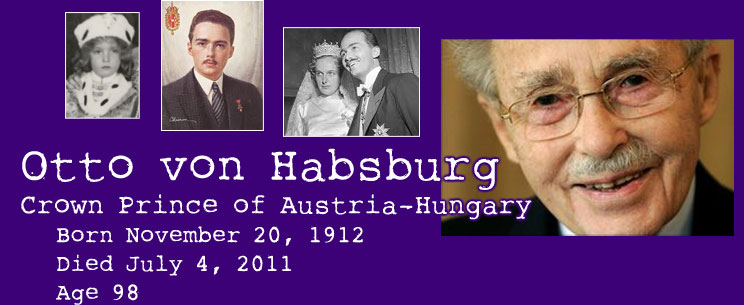 |
||||||||||||||
Franz Joseph Otto Robert Maria Anton Karl Max Heinrich Sixtus Xavier Felix Renatus Ludwig Gaetan Pius Ignatius von Habsburg was born at Reichenau an der Rax, Lower Austria. His father, Charles, would become Emperor of Austria and King of Hungary. Otto's mother was Zita of Bourbon-Parma. His great-uncle, Archduke Franz Ferdinand, whose assassination in 1914 would trigger the first world war, stood in for Otto's ancient godfather, the Emperor Franz Joseph, at his christening. Otto's father succeeded Franz Joseph in 1916, whereupon Otto became crown prince. (How was that for a Louis Epstein impression?) It was felt that, all things being equal, he would take his rightful place as the monarch at the end of the 20th century. Except all things weren't equal, not by a long shot. The Great War doomed Europe's empires, and the Habsburgs were among them. He and his family wandered around Europe trying to stay out of trouble, and then he reached his 18th birthday and was declared, albeit in a family ceremony, sovereign and head of the house. Then came Hitler. Otto snubbed him and it started a battle between the two men for what was to become of Austria, homeland to both. He volunteered to take over the Austrian government to fight Hitler, but it was not to be. He was on the Gestapo's most-wanted list, so he said so long farewell like the von Trapps and hightailed it to Lisbon and then to America, courtesy of Roosevelt, who couldn't be bothered to rescue the Jews, but thought a refugee like Otto von Habsburg was worth saving. Despite every effort to realize a conservative federation in Central Europe, he returned to a Danube basin controlled by the Communists. Then he got married, had a passel of kids, started writing and lecturing, renouncing his claims to the dynasty. He joined and ran all sorts of political parties, and helped organize the "pan-European picnic" on the Austrian-Hungarian border, one of the events that led to the fall of the Berlin Wall and Soviet communism. So Otto make his mark, after all. His story is a lot more complicated than I made it, but you get the idea. Patient Kathi gets the hit for 7 points. 2+5. Otto made it to the 21st century. He was 98. — Amelia |
||||||||||||||
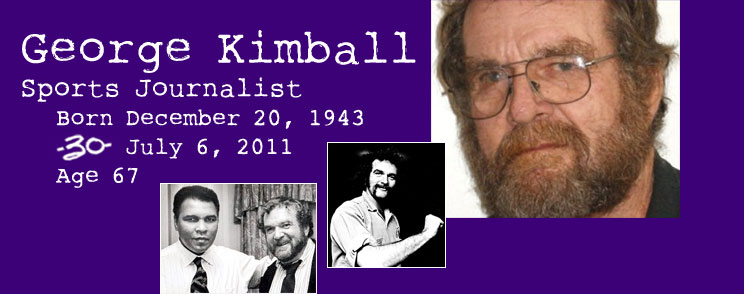 |
||||||||||||||
DDT gets the solo, 16 points, and my gratitude for volunteering and writing a terrific update. Good times. * * * George Kimball certainly dabbled during his career. In his time, he was a sports journalist, an author, a broadcaster, a raconteur and a beat poet. He once unsuccessfully attempted to become a sheriff in Kansas, and often visited his friend William Burroughs for lunch. Kimball was best known as a boxing writer, covering more than three hundred world title fights. He worked for the Boston Globe for more than twenty-five years and regaled the paper's readers with accounts of the coming-togethers of the world's finest pugilists. At a time when boxing was at its peak, when it ruled the primetime TV airwaves and when the champions of each weight division were household names, Kimball was always there to witness events first-hand, ready to translate the violence he watched into gentle prose. Towards the end of his career, Kimball's book "The Four Kings" was published to almost universal acclaim. His astutely observed account of the careers of Sugar Ray Leonard, Marvin Hagler, Thomas Hearns and Roberto Duran — boxing's quadrumvirate during the early 1980s — is widely regarded to be his finest hour. In many lyrical passages, Kimball revelled in the positively brutal evocation of punches thrown, splattered blood, flying gumshields, and prone bodies tumbling helplessly to the canvas. This work, variously described as a "thriller" and an "epic poem," promises to be his lasting legacy. George Edward Kimball III, the son of an army officer, was born in 1943 in California. After a much-travelled childhood, he enrolled at the University of Kansas on a Navy scholarship. As a student, Kimball morphed into a young man of firmly held radical beliefs and was arrested several times for marching against the war in Vietnam. Kimball's Navy sponsors were unimpressed at this turn of events, and his scholarship was promptly withdrawn. After expulsion from University, Kimball remained in the area, establishing links with other local counterculture figures and using a local bar as a platform to convey his poetry to the masses. It was around this time that Kimball lost an eye in a bar brawl. In 1970, just before a warrant was issued for his arrest on charges of inciting a riot, Kimball was selected to stand as the Democratic candidate to become sheriff of Douglas County in Kansas. Kimball promulgated a radical hippie agenda, claiming to represent the interests of "the street people." He was soundly beaten by the incumbent Republican candidate, Rex Johnson. Shortly afterwards, Kimball drifted to the East Coast, eventually settling in New York, where he embarked on an a brief and unsuccessful career as a pornographic novelist. After various spells writing for underground newspapers, he was taken on by the Boston Globe in 1980, and it was at this point that his career as a sports journalist took off. In 2005, only a year after marrying for the fourth time (the service was conducted by Reverend George Foreman), Kimball was diagnosed with inoperable oesophageal cancer. In 2008, he announced that he had a prognosis of "six weeks to two years." He continued to work through all of his treatment and, touchingly, less than a month before his own death, Kimball wrote a heartrending obituary for the similarly afflicted boxer Genaro Hernández, when he must have known that his own time was nearly up. — DDT |
||||||||||||||
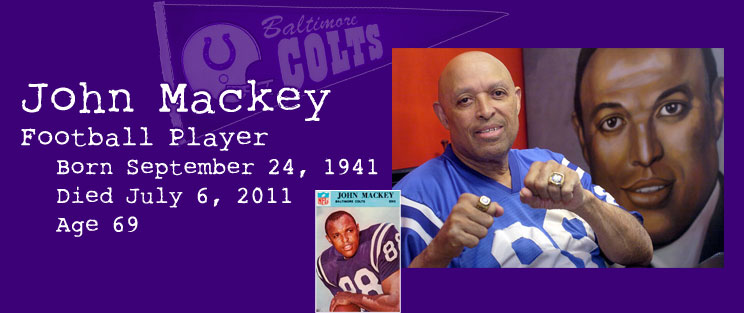 |
||||||||||||||
John Mackey, the NFL hall of famer who has died at 69, will be remembered by professional football fans mostly for the 1971 Super Bowl. He caught a pass that bounced out of the hands of another Baltimore Colts receiver, just nicking the fingertips of Mel Renfro, the Dallas Cowboys D-Back, and then he ran 70-plus yards for a touchdown. It was, however, after his football career that Mackey made his greatest impact on his peers. He became the first president of the NFL Players Association and organized a players' strike that ultimately earned them millions of dollars in benefits. And, in later years, when Mackey suffered from frontotemporal dementia, the NFLPA created the "Eighty-Eight Plan," which provides other retired NFL players with $88,000.00 in nursing home care and an additional $50,000.00 for adult daycare. John Mackey's number with the Colts was 88. Chaptal and Walking Dead Dude, who had him racked and stacked, will not be getting even 88 cents for this hit. They will each be getting eleven points plus three bonus points. Total: 14. You may both do your end-zone dance now. — Bill Schenley |
||||||||||||||
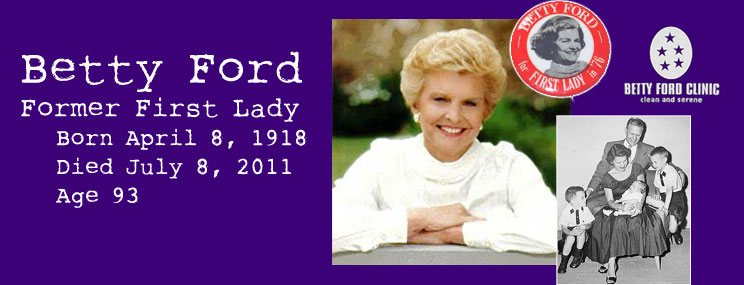 |
||||||||||||||
Betty Ford was an amazing woman. She spoke her mind on many occasions on many subjects that were taboo then and not much better now. With one radical mastectomy, she got millions of women to get checked for breast cancer. She had chemotherapy while she was in the White House. Did you know that? I didn't know that. Which means she was suffering and bald and scared and didn't let on. She thought there was entirely too much secrecy during the previous administration. This one would be different. Oh, boy, was it. She was an outspoken feminist, didn't always vote the same way her husband did, endorsed the ERA, was pleased with Roe v. Wade because it put abortions in hospitals and took them out of back alleys. She was an early proponent of help for AIDS victims. And when her family said enough with the booze and pills, she didn't hide in her room. She got help for herself. And every other person suffering from crippling addictions. She worked with Rosalyn Carter to press for health-care reform legislation that included mental illness and substance-abuse insurance coverage. She was chairman of the board of the facility that bears her name, and she helped expand its services to include family therapy programs and women's treatment centers. Her poll numbers were far better than her husband's. She was a remarkable lady and was rewarded with a very long life. Busgal, Chaptal, Dead Batteries, Dead People Server, DGH, Eternity Tours, Exuma, Jenstrikesagain, JTH, Kathi, Kathypig1, Kixco, Loki, Mo, Moldy Oldies, Ray Arthur, Roxanne Wiggs, The Wiz, Tim J and Worm Farmer are rewarded with 2, count 'em, 2 points. — Amelia |
||||||||||||||
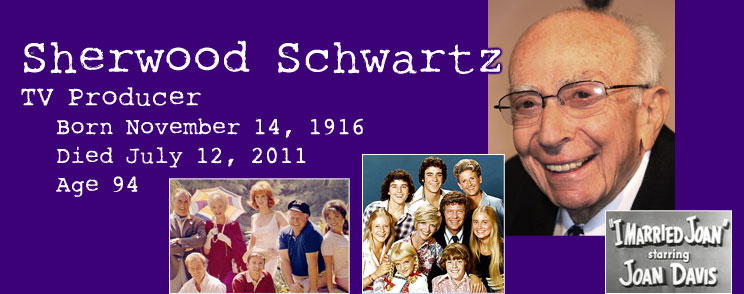 |
||||||||||||||
Sherwood Schwartz was supposed to be a doctor. He moved from New York to Los Angeles to study biology and then go on to medical school. Sherwood (and, yes, that was his real name) had a brother named Al, who had a good gig with Bob Hope's radio show. Sherwood lived with Al in Al's big apartment while he was finishing his biology degree. Unfortunately, work was scarce, and Sherwood's applications to medical schools were going nowhere. Sherwood asked Al if he could freelance some jokes for Bob Hope, because a single good joke could pay as much as ten bucks, and ten bucks in those days would keep you eating for a week. Al said sure, and it turned out that Bob Hope liked Sherwood's stuff. A few months later, Sherwood was on Hope's writing staff and the world had lost a doctor. That was in 1938. Sherwood's job with Bob Hope lasted more than four years. It would have been longer, except that World War II started, and Sherwood was drafted into the Army. In uniform, Sherwood kept on writing radio shows; he just got paid a lot less for it. After he was discharged, Sherwood wrote for the radio version of The Adventures of Ozzie and Harriet, a long-running series about a suburban white family that never really had any problems worth mentioning. Perhaps because of that, the show went on and on for decades. Sherwood remembered that. Then came television, and radio was suddenly passé. Sherwood made the leap and landed on the writing staff of a series called I Married Joan. The "I" was played by Jim Backus. (Sherwood remembered that, too.) I Married Joan was a sitcom about the adventures of a wacky housewife and the emotional abuse she wreaked on her stolid husband. Sherwood stuck with I Married Joan through the show's three seasons, and then he went to work for Red Skelton. CBS wanted Sherwood to take over Red's show as head writer because it was failing, but Sherwood didn't want to work for Red Skelton. Sherwood said Red was "crazy" and a "nut." He once told a story about how Red had fired a gun at the feet of his previous head writer to "teach him to write funnier." Sherwood told CBS that he didn't want to do Red's show because he had ten toes and was very fond of all of them. Eventually Sherwood did take the job, but not until it was put in his contract that he never, ever had to meet with Red Skelton. Sherwood fixed the show and held the job for seven years, and he never once met with Red. Right after that, in 1963, Sherwood became script supervisor for the Ray Walston sitcom My Favorite Martian. And then came Gilligan's Island. Sherwood once told tvparty.com that he'd "wanted to do a show about democracy, in its basic form. Seven people who have to learn to live together. I couldn't do that with a job because you can get fired. Where could I put people where they could not get away from each other? That's what started that show. The only place I could think of was an island, a deserted island, where a group of people were for some reason stranded there." The audience could perhaps be forgiven for missing the subtext about democracy, what with all the slapstick and nobody asking the professor to just go ahead and fix the goddamn boat. What Gilligan's Island really was, was the Skipper and Gilligan, Laurel and Hardy, and that always plays well. Sherwood cleverly avoided having to make an origin episode by putting the entire backstory into the theme song he'd written; the cast remained the same throughout the series; and there never was a rescue episode. The show was also pretty funny. Because of all those things, Gilligan's Island runs and runs and runs on an infinite loop, with no beginning or end, as it has done now for nearly fifty years. It has been shown on TV more often than any other series, having surpassed I Love Lucy's total a few years before the century ended. Sherwood's next series, It's About Time, was a bomb. He wrote the theme songs — both of them — for this one. Two astronauts accidentally go back in time to the Stone Age. When the show falls in the ratings, the astronauts somehow fix their spaceship and return to the 1960s, bringing some cave people along with them. Both versions were terrible. Nevertheless, people remember the theme song — or songs, if they're really good at remembering fluff. As Sherwood said, "The only thing people remember about that show is the theme song." (Well, I remember one other thing: In the first episode, the cave wife [played by Imogene Coca] was named Shag. Somebody at CBS then found out what "shag" meant in the UK, so her name was changed in later episodes to Shad.) Then came Sherwood's other huge success, The Brady Bunch. Some think of this one as the last of the old-style family sitcoms. Maybe, maybe not. Once again it's got one of those Sherwood "I don't have to do an origin episode" Schwartz theme songs. Two widowed parents marry and form a blended family, and there's also a helpful maid and, briefly, a dog. The Brady Bunch followed the success of the unrelated but thematically similar theatrical film Yours, Mine and Ours by a year, but The Brady Bunch had only six kids in it instead of 19. The Brady Bunch will likely continue running for decades to come, and it's inspired a number of successor series and films. After The Brady Bunch, Sherwood produced a handful of TV shows, none of them memorable. The last one, Together We Stand, was a short-lived disaster that ran during the 1986-87 season. After that, Sherwood began writing for the stage, and in 1990 he came up with a musical based on Gilligan's Island. That one still plays around the world. Of course. Little buddies Constant Irritant, Deepstblu, Happy No Year, Kixco, Loki, The Wiz and Tim J each get two points. — Brad |
||||||||||||||
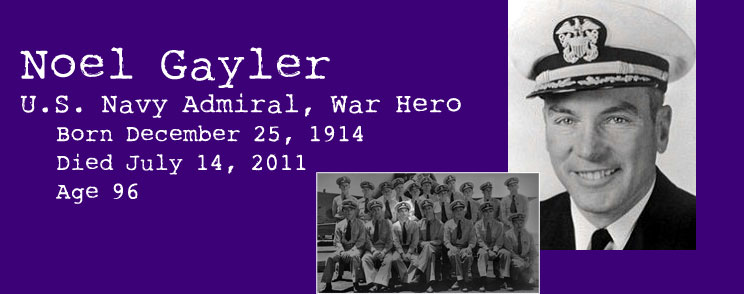 |
||||||||||||||
JD Baldwin wrote this. He kept apologizing to me, and even does so in the update itself about the quality. He's insane. It's brilliant. * * * This is (around) the eighteenth and (definitely) FINAL draft of this update. Every other Noel Gayler update I drafted was as much about me as it was about him, and that's wrong. This one, I am sure, will be just as bad but screw it, I'm done. I have to preface this by saying I do have a Louis Epstein-like rule about the dead pool. I won't play someone whom I personally know is in poor health. I knew Noel Gayler, but I hadn't been in touch with him for over a decade, so I didn't consider it at all sketchy to play him. I honestly just threw his name in on the basis of, "Hey, this guy's getting old and he's likely to be a solo, why not?" In fact, I didn't even know he'd died until someone (another public figure, BTW) mentioned it in an email that was forwarded to me for other reasons. Three months after the event. And here's the update two months later ... Noel Gayler was not your ordinary peacenik. When one of my professors (for a one-credit preparatory "reading seminar," no less) told me the class would be having a dinner party at his house with Noel Gayler of the Center for Defense Information, I almost laughed out loud. Those CDI weirdos were a bunch of naive "useful idiots" doing Yuri Andropov's work for him. They had some wildly naive ideas about war and national security that, if they hadn't been so marginalized, might have been doing real harm. I also knew I had a personal connection with the man: He and my grandfather had been pretty good friends — classmates, commissioned together, served in their first sea tour together. (Gayler was the only one of my grandfather's classmates to reach four-star flag rank.) Well, I called my grandfather and found out that ol' Noel had a pretty good résumé for talking about war and national security:
I don't care what he's advocating, from unilateral disarmament to replacing the M1911A1 with some Beretta 9mm piece of shit. This guy has earned a fair hearing. (I don't think he wanted to get rid of the M1911A1. Because he wasn't a goddamned retard.) Even a service record like that one hardly means that every pronouncement he made on national security was steeped in Pure Wisdom, of course. In fact, much as military veterans tend to make appalling commanders-in-chief when elected to the presidency [1], and the non-veterans and dilettantes are often quite good and sometimes brilliant, such deep qualifications might actually work against him in that department. But you at least sit up and listen carefully. So, what does a young, hyper-conservative, hawkish midshipman ask a guy like that? He asks what it's like to fly Wildcats, of course. And the answer (my paraphrase, not Admiral Gayler's direct wording) is that it is totally bitchin'. But in more general discussions, I learned a lot about nuclear war planning, what kinds of things go into various elements of SIOP [2], which served me very well in later years when I was one of only two students in my Naval War College class who was remotely literate with those issues. (The other guy had been to Command and Staff College, which is just cheating.) So thanks for that, Admiral. And thanks for a bunch of other stuff, too. I got a perspective on national defense that I needed, whether I knew it at the time or not. One thing Gayler didn't know at the time himself was that the then-C-in-C, Ronald Reagan, was evolving strongly toward a similar point of view to Gayler's own: The policy goal should be to eliminate all nuclear weapons worldwide. Now, that is of course naive. And even the older, wiser JD Baldwin thinks Gayler was pretty deeply wrong. (The "nuclear freeze" option, strongly and sneeringly advocated by Gayler, would have been the single most foolish thing to which the U.S. could have agreed in the early 1980s.) Even Gayler admitted later in life that the Reagan Administration was playing a deeper game against the USSR than he suspected — or even suspected was possible. (Quote from Gayler — paraphrased — in about 1985: "The USSR is going to be around in its present form for another hundred years at least, assuming we can keep nuclear peace. So we're just going to have to learn to live with them.") And I have to state with disappointment that he wasn't exactly gracious about it when Reagan's stubborn hard line yielded the IMF Treaty, which should have been an anti-nuke hippie's wet dream. But whether he was right or wrong isn't really the point. It isn't even important. While I don't want to overstate the depth of the relationship I had with the man (an occasional letter or telephone call, rarely delving into politics or policy matters), I did consider him a mentor. And one of my fonder memories is his response when I sent him a USS Ranger patch after I was assigned to the base where she was homeported. (A little side story about Gayler: When he finished his term as director of the National Security Agency, he was promoted to four-star rank and made USCINCPAC, the theater commander of all U.S. forces in the Pacific region. That was an unprecedented leap — like going from branch manager to president of a large bank in one shot. Around ten years later, when Admiral Bobby Inman finished at NSA, he lobbied to be made USCINCPAC. He wasn't even a line officer. This wasn't exactly the first indication anyone had of Inman's arrogance, but it was a memorable moment in underscoring just how far "out there" the man could be.) Admiral Gayler unilaterally disarmed last July 14th (a French national holiday, and doesn't that just make perfect sense?). JD Baldwin scores a mere two countervalue points based on the target's age (96) but gets five counterforce points for the solo. Total: 350. Oh, wait — for a second there I thought I was a CIA analyst estimating Soviet missile force capabilities. Total: 7. — JD Baldwin [1] Seriously. Go make a list sometime, you'll see. FDR, Lincoln and Ronald Reagan vs. LBJ, Grant and Bush 41. (Woodrow Wilson would be a singular and glaring exception to the rule.) [2] http://en.wikipedia.org/wiki/Single_Integrated_Operational_Plan |
||||||||||||||
 |
||||||||||||||
"Three Gals, Three Guitars, One Birthday." That was the sell line for the Del Rubio Sisters, and it's a shame that they didn't go for the alliteration of One Gestation ... but theirs was not a highbrow act. Edith, Elena and Mildred Boyd were all born within a 30-minute period in the Panama Canal Zone. They lived there and in Washington, D.C. during their early lives. When they turned 14 and their father had once again failed to talk them out of going into show business, he bought them three identical Martin guitars. The sisters used them for the rest of their lives. The girls began bleaching their hair an unnatural blonde right after high school. Elena said that their dad was crazy about blondes, even though he'd married a brunette. They were still the Boyd Sisters then, as they began working lounges and church dances. They also came up with a dance act, but it wasn't very good. The Boyd Sisters changed their name when Elena decided she liked it when their Latino fans called them "las rubias," Spanish for "the blondes." They made it masculine and singular, though. Eadie once said they preferred the way that sounded. Although they're seen as an '80s phenomenon, the Del Rubios were working more or less steadily from the age of 18 on. Multiple sources claim they appeared on one of Bob Hope's TV specials in the '50s. In 1962 they self-financed a "world tour" and traveled widely for three years, but returned home when their mother suffered a stroke. After lingering for some months, she died. The gals retired the act and lived off their inheritance. They bought a three-bedroom mobile home in San Pedro, California and lived together there. The trailer was on a nice plot overlooking the Pacific. They didn't perform again for another five years. In 1970 the sisters began singing again, touring retirement homes and the like, in memory of their mother. They got around in an old station wagon they named Bambi. They cultivated their act: a repertoire of current rock and pop standards sung pleasantly while accompanied on guitar. They wore bright costumes that always included a miniskirt, which became and remained their signature, even as they aged. It wasn't until 1987 that the Del Rubios broke through. The songwriter Allee Willis (who's probably best known for having written the theme song for the TV series Friends) had found out about them a couple of years before and had become a fan. She booked the Del Rubios for one of those too-cool parties the L.A. art people throw for each other every so often, and the Del Rubios instantly became famous within that community. They began getting gigs on TV, and their agreeable appearance on Pee-wee Herman's 1988 Christmas special made them nationally famous. Here they are, singing "Winter Wonderland" (and, yes, that's Laurence Fishburne with Pee-wee). The now constantly employed Del Rubios remained inseparable. None of them ever married or, it seems, had a serious relationship outside their circle of three. Eadie would say that God came first, followed by her sisters, and music third. Love was a distant fourth. It was true for them all. The act ended when Eadie was diagnosed with cancer in 1996; she died just before Christmas of that year. Elena and Milly continued to live together in the big trailer until Elena died ten years ago. And now Milly has joined them. They're all buried together in a family plot at Holy Cross Cemetery in Culver City, California, and none will ever be far from the others. Allee Willis told dailybreeze.com, "They honestly enjoyed performing more than anyone I ever met. Most of the people I know, most of my music peers, have had a lot of hits and everyone worries about the next hit. They just didn't care. They loved putting on those miniskirts and they loved playing those guitars. They were such characters." * * * Grim McGraw (first hit of the year!!) and Happy No Year share the Del Rubio duet, and it's just a damn shame that it wasn't a trio. Eight points each. — Brad |
||||||||||||||
 |
||||||||||||||
Lovely Jim Thornton volunteered for Amy and he did a splendid job, complete with poetry. Thanks, Jim, and happy birthday. I'll begin with the poolers who included her. They each get 47 points — 22 points based on her age and an additional 25 points for having picked the youngest AO Deadpool hit of 2011: Allen Kirshner, Allezblancs, Brigid, Busgal, Chaptal, Dead People Server, Deepstblu, Denise, Fireball, Jenstrikesagain, Jim Thornton, Kathypig1, Mark, Moldy Oldies, Sarndra, The Wiz and Undertaker. Boy, did the standings change. * * * No need to follow her career closely to have seen this coming. Only those who thought, implausibly, that her public image was faked up, failed to predict Miss Winehouse. Her voice was great, but men and drugs let her down. Her jazz-loving, taxi-driver father left home when she was a child, only to come back into her life when she was famous. Blake Fielder-Civil, her on-off boyfriend and husband-for-a-bit, a minor drug-dealer and brawler, was little better. Her tough exterior may have helped with difficult boyfriends, but the little girl inside was never strong enough to cope with the poisons she ingested. Cigarettes gave her emphysema, alcohol made her fall over, and the illegal stuff had worse effects. Soon a near death-cult developed around her, fueled by funeral videos and rumours of wrist-cutting parties. Her biggest hit single, "Rehab," a celebration of fatalistic refusal of addiction treatment, became almost a personal anthem. Karl Lagerfeld, to his shame, even developed a fashion line around her, based on sickly drug-addled girls. Even if the cigarettes improved her voice, the rest of her troubles did her no good at all. In the eight years after her debut album "Frank," she managed only one other, her masterpiece "Back to Black." Although she won awards and sold many records, for the last few years of her life she was much more famous for her ever-enlarging beehive hairdo, love life and drug-taking. Like Janis Joplin, another talented singer with a memorable voice and problem hair, the bad end came at the young age of 27. Some pundits blame her managers for not looking after her better and others the paparazzi for pestering her, but that's hardly fair; the rest of us bought the papers and the fashions, and ultimately no one forced the drugs on her. She sniffed, injected and swallowed them herself, bought and paid for. "Back to Black" and "Love is a Losing Game" are my favourites. Here's a poem.
|
||||||||||||||
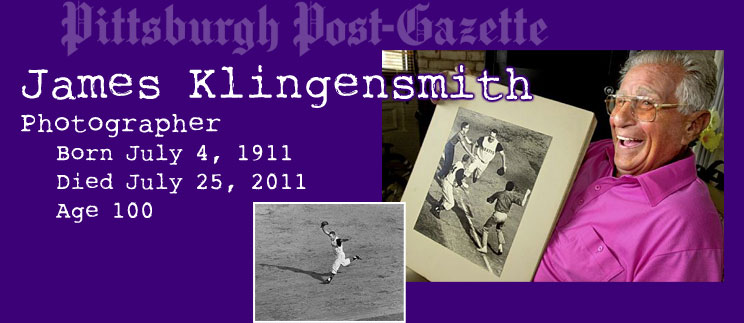 |
||||||||||||||
James G. Klingensmith, who was 100 when he finally died, was a photographer who specialized in gruesome pictures that were meant to haunt children for years to come. One in particular stands out; it depicts a terrifying man, in some god-awful clown suit, chasing away the dreams of a wide-eyed, unsuspecting child. Because of some kind of free-press rule, or law, or something, somewhere, Klingensmith was allowed to continue tormenting children until late in his life when, fittingly, one of his cruel, red, gleaming, soul-sucking eyeballs fell out of his evil, wrinkled and creased head and was accidentally stepped on by an innocent little boy wearing a New York Yankees cap. The boy meant no harm. Well played, Klingensmith, you bastard. But I get the last laugh. You're dead and I'm not ... at least for a few days. I get one point for the hit and five bonus points for the solo shot in the bottom of the ninth that went all the way to Schenley Avenue. Total: 6. — Bill Schenley |
||||||||||||||
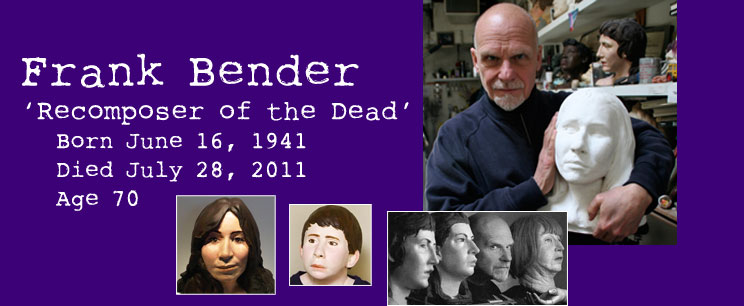 |
||||||||||||||
The forensic bust Frank Bender created with the hope of bringing about the arrest of a man who for eighteen years had escaped punishment for murdering his mother, his wife and three children, brought Mr. Bender a mild level of fame and a great deal of satisfaction. But Bender, who studied at the Pennsylvania Academy of Fine Arts, was much more than the forensic artist who brought the man who killed John List Jr. and his family to justice. He was called "The Recomposer of the Decomposed" who was able to identify, with just the skull, Rosella Atkinson, who had been murdered at 18. Her killer confessed. Since 1993, the bodies of over four hundred women known as the "feminicidios" have been found in the desert surrounding Ciudad, Mexico. Bender, in an attempt to identify these faceless victims, recreated eight of these women. Three of these women were identified as a result of Bender's magic. Frank Bender, along with two other men, founded The Vidocq Society, which is a group consisting of forensic scientists, law enforcement officers and other professionals who investigate unsolved murders throughout the United States. Frank Bender was 70 when he died in Philadelphia. He seemed to have the eerie ability to bring back the dead. Both Gerard Tierney and Morris the Cat are hoping Frank Bender has no more tricks up his sleeve. They're hoping he can't bring himself back ... because they both want the eight points for the hit and the three bonus points. Total: 11. — Bill Schenley |
||||||||||||||
